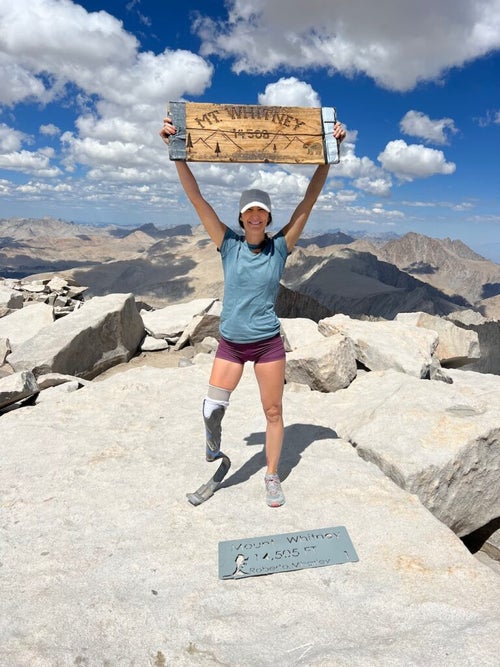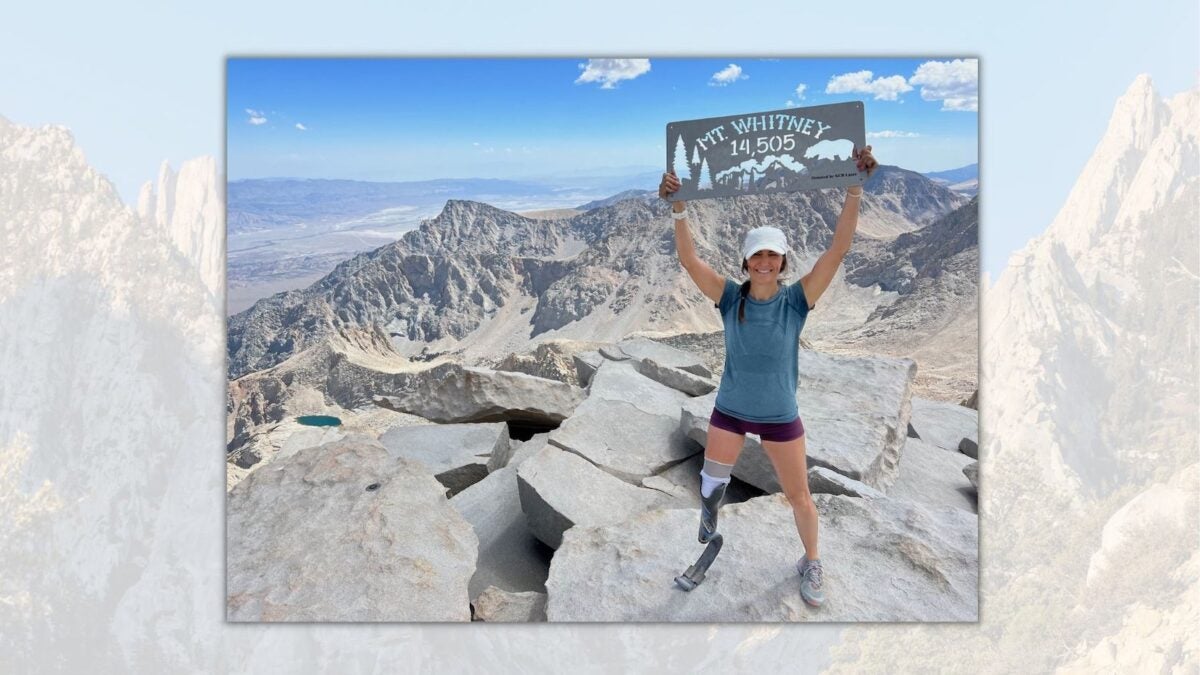Products You May Like
Get access to everything we publish when you
sign up for Outside+.
Climbing Mount Whitney (“Tumanguya” to the Indigenous Newe, or Shoshone) became a bucket list peak shortly after a cross-country move took me from the rolling hills of North Carolina to the steep, rocky mountains of southern California.
On weekends I would drive further from my home in San Diego, to the cooler temperatures and more secluded trails in the neighboring mountains. Southern California has several local peaks, and in no time, I had run them all – San Gorgonio, San Bernardino, San Antonio (Mount Baldy), and San Jacinto.
I widened my search radius for “local” climbs, and that’s how Mount Whitney came onto my radar. Located on the east side of the Sierra Nevada mountains, Mount Whitney stands 14,505 feet tall, making it the highest peak in the lower 48 states. Starting at the Whitney Portal, on the outskirts of Lone Pine, the Mount Whitney Trail snakes up through Inyo National Forest before reaching the peak in Sequoia National Park. Intrigued, I followed the links to enter my name in the lottery. A few months later, I opened my inbox to find a congratulatory email and a link to my permits.
It was early September and the sun was peeking over the horizon as my running partner and I worked our way through Alabama Hills and into the parking lot at Whitney Portal. The air was cool as I pulled on my running blade, then laced up my other shoe.

We set off up the incline, pushing ourselves easily while our legs were still fresh. At mid-morning, the trail was lightly trafficked. We exchanged pleasantries with a few hikers, most of them on their way back down after an overnight stay along the 22-mile trail. As they stepped aside for us to pass, I could sense their quizzical looks at my running blade. This was usually followed by a few encouraging words before they disappeared down the trail below us.
Most people don’t know what to say as I run towards them on a rocky trail with a carbon fiber blade on my right lower leg. I’ve had a prosthesis since before I learned to walk, since my right foot and ankle were amputated when I was six months old because of a rare bone defect. For those I pass on the trail, the traditional view of a handicap is called into question. One might assume that, with loss comes a disability, and with a disability comes limits. Suddenly, the limits are no longer so clear.
RELATED: UTMB-bound Athlete Zachary Friedley is Opening the Trails to Adaptive Athletes
Our pace slowed as we came upon the infamous “97 switchbacks” (99, depending on when you start counting), a 2.2-mile segment of jagged trail climbing up 1,600 feet. My breathing turned ragged and my heart rate jumped. I was beginning to feel lightheaded and nauseous from the combination of altitude, increased effort, dehydration, and low blood sugar. Without an ankle to absorb the trail’s uneven surface, the foot of my running blade bounced off rocks into awkward angles.
With my eyes trained on the trail, I focused on putting one foot in front of the other. My head felt foggy as I pushed closer to my physical limits. The rocky terrain strained my prosthesis, each step catapulting me dangerously close to the edge of the trail as we rounded each switchback. I could feel the stress loaded into my right hip as it stabilized the rest of my lower prosthetic limb. My left quadricep muscles burned as my sound leg propelled me up the steep incline, making up for the lack of muscle in my amputated leg.
As we ticked off the last of the switchbacks and crested the east side of the mountain, I turned back to see my running partner close behind me. The fatigue showed on her face. We had ascended a notoriously challenging section of the Whitney climb at a pace that left even my well-conditioned, able-bodied trail companion winded.
No one teaches us about resilience as children; we either learn it or we don’t. I was lucky enough to be born into a situation that fostered it.
During my lowest moments, I coveted what I lacked – two “normal” legs – but that was a fleeting thought as I was reminded of how fortunate I was to be out there at all. It was replaced by a profound sense of gratitude for my health, for my prosthesis, and for being instilled with a mindset to acknowledge my difference but not let it hold me back.
After my leg was amputated, I naturally learned to push myself so that I could keep up with other kids my age. I had no idea then what impact my early experience would have on the rest of my life. No one teaches us about resilience as children; we either learn it or we don’t. I was lucky enough to be born into a situation that fostered it. Either I had to learn to do the best I could with what I had, or I’d spend the rest of my life feeling sorry for myself. Choosing to put myself in situations outside my comfort zone allowed me to see what I was capable of.

Back on the Mount Whitney Trail, my running partner and I marveled at the segment we now had behind us and welcomed the subtle downhill as we entered Sequoia National Park. An hour later we were greeted by the welcome site of the Mount Whitney Hut, yards away from the actual summit. After a brief stop for photos and to top off our energy stores, we were back on the trail, winding down toward the car.
RELATED: Run Your Best Races In 2023 With Our Training Plans For Every Distance
I continued to ride the highs and lows of the day as we peeled off our sweat-soaked layers and wrapped up into a pair of dry sweats. Before we knew it, Mount Whitney was a speck in the rearview mirror as we headed back to Lone Pine to celebrate with a well-deserved burger and beer. My muscles protested as I climbed out of the car, stiff and sore from the impact of so many miles, but that would all fade.
What wouldn’t fade was knowing that I had summited the highest peak in the continental United States. I tucked this fact away as a reminder that I can do hard things. Each success helps me build the confidence to face something equally difficult, or perhaps even more challenging, in the future. It reinforces my ability to overcome the physical and mental blocks that urge me to quit, or not start at all. Just as the Southern California peaks I’d ascended before were a stepping stone to Mount Whitney, so too will Mount Whitney be a stepping stone to another bigger challenge in the future.
Kelly Bruno is an avid runner, activist for adaptive athletes, moderate feminist, chronic pain specialist, health and wellness expert with a passion for preventative medicine, and advocate for diversity and equality in medicine. She is best known for her role as a contestant on Survivor: Nicaragua (Season 21) and as the first “disabled ballgirl” at the US Open.
